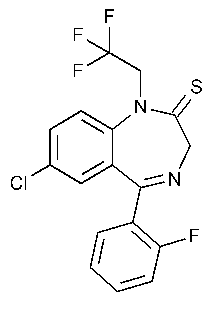Quazepam
2H-1,4-Benzodiazepine-2-thione,7-chloro-5-(2-fluorophenyl)-1,3-dihydro-1-(2,2,2-trifluoroethyl)-.
7-Chloro-5-(o-fluorophenyl)-1,3-dihydro-1-(2,2,2-trifluoroethyl)-2H-1,4-benzodiazepine-2-thione [36735-22-5].
»Quazepam contains not less than 98.5percent and not more than 101.5percent of C17H11ClF4N2S,calculated on the dried basis.
Packaging and storage—
Preserve in well-closed containers.
Identification—
A:
Infrared Absorption á197Mñ.
B:
The RFvalue of the principal spot in the chromatogram of the Test solutionobtained in the test for Related compoundscorresponds to that in the chromatogram of Standard solution A.
Melting range á741ñ:
between 146 and 151
and 151 ,but the range between beginning and end of melting does not exceed 2
,but the range between beginning and end of melting does not exceed 2 .
.
Loss on drying á731ñ—
Dry it at 105 for 4hours:it loses not more than 0.5%of its weight.
for 4hours:it loses not more than 0.5%of its weight.
Residue on ignition á281ñ:
not more than 0.2%.
Heavy metals,Method IIá231ñ:
not more than 20µg per g.
Related compounds—
Test solution—
Prepare a solution of Quazepam in methylene chloride containing 20mg per mL.
Standard solution A—
Dissolve an accurately weighed quantity of USP Quazepam RSin methylene chloride to obtain a solution having a known concentration of about 20mg per mL.
Standard solution B—
Dissolve an accurately weighed quantity of USP Quazepam RSin methylene chloride to obtain a solution having a known concentration of about 0.04mg per mL(0.2%).
Standard solution C—
Dissolve an accurately weighed quantity of USP Quazepam Related Compound A RSin methylene chloride to obtain a solution having a known concentration of about 0.2mg per mL(1%).
Procedure—
Separately apply 5µLof the Test solutionand 5µLof each of the Standard solutionsto a thin-layer chromatographic plate (see Chromatography á621ñ)coated with a 0.25-mm layer of chromatographic silica gel.Allow the spots to dry,and develop the chromatogram in a solvent system consisting of a mixture of cyclohexane,ethyl acetate,and ether (170:40:25)in a paper-lined tank until the solvent front has moved about three-fourths of the length of the plate.Remove the plate from the developing chamber,mark the solvent front,allow to air-dry,and examine the plate under short-wavelength UVlight.Compare the intensity of the secondary spot in the chromatogram of the Test solutionhaving the same RFvalue as that of the primary spot of Standard solution C:the spot is not larger or more intense than the principal spot in the chromatogram of Standard solution C.Compare the intensities of any additional secondary spots observed in the chromatogram of the Test solutionwith that of the principal spot in the chromatogram of Standard solution B:the sum of the intensities of the additional secondary spots obtained from the Test solutioncorresponds to not more than 0.2%.
Assay—
Dissolve about 500mg of Quazepam,accurately weighed,in 150mLof acetic anhydride.Titrate with 0.1Nperchloric acid VS,determining the endpoint potentiometrically,using a glass-calomel electrode system.Perform a blank determination,and make any necessary correction.Each mLof 0.1Nperchloric acid is equivalent to 38.68mg of C17H11ClF4N2S.
Auxiliary Information—
Staff Liaison:Ravi Ravichandran,Ph.D.,Senior Scientist
Expert Committee:(PA3)Pharmaceutical Analysis 3
USP28–NF23Page 1688
Phone Number:1-301-816-8330
